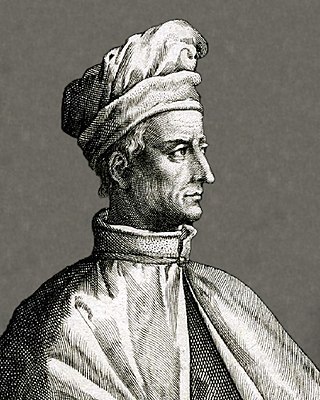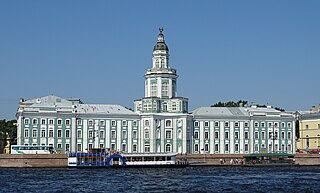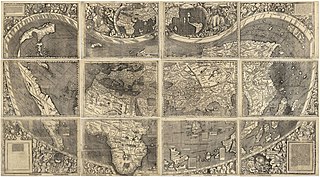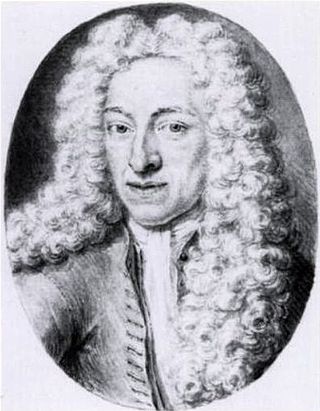Related Research Articles

Amerigo Vespucci was an Italian explorer and navigator from the Republic of Florence for whom "America" is named.

Martin Waldseemüller was a German cartographer and humanist scholar. Sometimes known by the Hellenized form of his name, Hylacomylus, his work was influential among contemporary cartographers. His collaborator Matthias Ringmann and he are credited with the first recorded usage of the word America to name a portion of the New World in honour of Italian explorer Amerigo Vespucci in a world map they delineated in 1507. Waldseemüller was also the first to map South America as a continent separate from Asia, the first to produce a printed globe, and the first to create a printed wall map of Europe. A set of his maps printed as an appendix to the 1513 edition of Ptolemy's Geography is considered to be the first example of a modern atlas.

Frederik Ruysch was a Dutch botanist and anatomist. He is known for developing techniques for preserving anatomical specimens, which he used to create dioramas or scenes incorporating human parts. His anatomical preparations included over 2,000 anatomical, pathological, zoological, and botanical specimens, which were preserved by either drying or embalming. Ruysch is also known for his proof of valves in the lymphatic system, the vomeronasal organ in snakes, and arteria centralis oculi. He was the first to describe the disease that is today known as Hirschsprung's disease, as well as several pathological conditions, including intracranial teratoma, enchondromatosis, and Majewski syndrome.

Antillia is a phantom island that was reputed, during the 15th-century age of exploration, to lie in the Atlantic Ocean, far to the west of Portugal and Spain. The island also went by the name of Isle of Seven Cities.

The Isle of Demons is a phantom island once associated with Quirpon Island, Newfoundland, in Canada. It was generally shown as two islands. It began appearing on maps in the beginning of the 16th century and disappeared in the mid-17th century. It could also simply be a translation from First Nations people who often avoided areas where a person had died, believing it was haunted by spirits. This results in many islands with the same naming theme.

A funeral director, also known as an undertaker or mortician, is a professional who has licenses in funeral arranging and embalming involved in the business of funeral rites. These tasks often entail the embalming and burial or cremation of the dead, as well as the arrangements for the funeral ceremony. Funeral directors may at times be asked to perform tasks such as dressing, casketing, and cossetting with the proper licenses. A funeral director may work at a funeral home or be an independent employee.

Rachel Ruysch was a Dutch still-life painter from the Northern Netherlands. She specialized in flowers, inventing her own style and achieving international fame in her lifetime. Due to a long and successful career that spanned over six decades, she became the best documented female painter of the Dutch Golden Age.

Matthias Ringmann (1482–1511), also known as Philesius Vogesigena, was an Alsatian German humanist scholar and cosmographer. Along with cartographer Martin Waldseemüller, he is credited with the first documented usage of the word America, on the 1507 map Universalis Cosmographia in honour of the Italian explorer Amerigo Vespucci.
Inventio Fortunata, "Fortunate, or fortune-making, discovery", is a lost book, probably dating from the 14th century, containing a description of the North Pole as a magnetic island surrounded by a giant whirlpool and four continents. No direct extracts from the document have been discovered, but its influence on the Western idea of the geography of the Arctic region persisted for several centuries.

The Kunstkamera or Kunstkammer is a public museum located on the Universitetskaya Embankment in Saint Petersburg, facing the Winter Palace. Its collection was first opened to the public at the Summer Palace by Peter the Great in 1714, making it Russia's first museum. Enlarged by purchases from the Dutch collectors Albertus Seba and Frederik Ruysch, the museum was moved to its present location in 1727. Having expanded to nearly 2,000,000 items, it is formally organized as the Russian Academy of Science's Peter the Great Museum of Anthropology and Ethnography, abbreviated in Russian as the МАЭ or МАЭ РАН.

The term "New World" is used to describe the majority of lands of Earth's Western Hemisphere, particularly the Americas. The term arose in the early 16th century during Europe's Age of Discovery, after Italian explorer Amerigo Vespucci published the Latin-language pamphlet Mundus Novus, presenting his conclusion that these lands constitute a new continent.
The earliest known world maps date to classical antiquity, the oldest examples of the 6th to 5th centuries BCE still based on the flat Earth paradigm. World maps assuming a spherical Earth first appear in the Hellenistic period. The developments of Greek geography during this time, notably by Eratosthenes and Posidonius culminated in the Roman era, with Ptolemy's world map, which would remain authoritative throughout the Middle Ages. Since Ptolemy, knowledge of the approximate size of the Earth allowed cartographers to estimate the extent of their geographical knowledge, and to indicate parts of the planet known to exist but not yet explored as terra incognita.

The Waldseemüller map or Universalis Cosmographia is a printed wall map of the world by German cartographer Martin Waldseemüller, originally published in April 1507. It is known as the first map to use the name "America". The name America is placed on South America on the main map. As explained in Cosmographiae Introductio, the name was bestowed in honor of the Italian Amerigo Vespucci.
Ruysch or Ruijsch is a Dutch patronymic surname, derived from the archaic Dutch given name Ruis. Variant forms are Ruijs, Ruis and Ruisch. People with the surname include:
Johannes Ruysch, a.k.a. Johann Ruijsch or Giovanni Ruisch was an explorer, cartographer, astronomer, manuscript illustrator and painter from the Low Countries who produced a famous map of the world: the second oldest known printed representation of the New World. This Ruysch map was published and widely distributed in 1507.
The Contarini–Rosselli map of 1506 was the first printed world map showing the New World.

Caspar Commelijn or Caspar Commelin, was a Dutch botanist.
The island of Satanazes is a legendary island once thought to be located in the Atlantic Ocean, and depicted on many 15th-century maps.

Candyn was a supposed remote east-Asian island around the turn of the 15th century.
References
- ↑ McGuirk, Donald L. Jr. (1989). "Ruysch World Map: Census and Commentary". Imago Mundi . 41: 133–141. doi:10.1080/03085698908592674.
- ↑ Damkaer, David M. (2002). The Copepodologist's Cabinet: a biographical and bibliographical history, Volume 1. American Philosophical Society. p. 15. ISBN 978-0-87169-240-5.